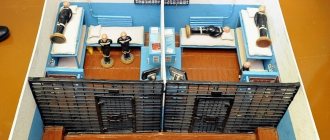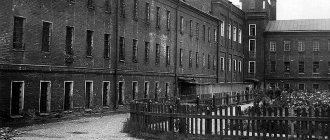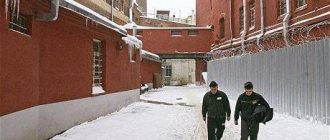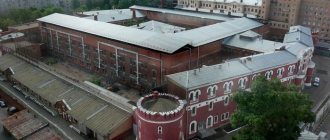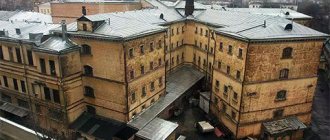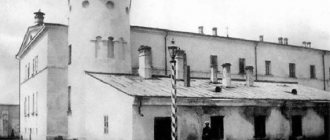Author: PREDATOR
January 30, 2016 16:00
Tags: White Swan prison history facts
114928
11
"White Swan" is a special regime prison. Its former name was “VK-240/2”. The official name today is FBU IK-2 GUFSIN. At the moment, “White Swan” is a prison that houses more than two and a half thousand prisoners. Its capacity limit is 510 seats. Let's take a closer look at what the White Swan prison is. The history of where the institution is located - all this information will also be given below.
0
See all photos in the gallery
General information
The institution is located in the Perm region, in the city of Solikamsk. The address where the White Swan prison is located is st. Karnallitovaya, 98. The correctional facility employs 564 people. A specialized basement workshop is also provided on the territory of the zone. It employs about 700 cabinetmakers. The institution operates at its own expense. Meat, vegetables, and poultry are prepared here. A greenhouse was also built on the premises. Greens, cucumbers, etc. are planted in it. Cultural development is also provided for in the White Swan FBU. The women's prison, located nearby, sometimes sends the theater of jokes and parodies "Matryoshka Show" to the institution with concerts. In the center of the territory there is a small Orthodox church. It was built by the prisoners themselves. The consecration of the icons and the church itself was carried out by a minister from Solikamsk. He comes to the territory where the White Swan prison is located on all Orthodox holidays. The minister teaches prayer, conducts baptismal ceremonies, and reads the liturgy.
×
0
Brief description of the Solikamsk special regime prison
The White Swan prison is located at Perm Territory, Solikamsk, st. Karnalitovaya, 98 (index – 618545).
Email addresses:
Mode: special.
Telephones and faxes of the main persons for receiving citizens on personal matters are presented in the table:
| Full name, position | Phone number | Business hours |
| Khomko Viktor Konstantinovich, head of the colony | 8-342-537-21-36 | Wed, from 15:00-16:00 |
| Ignatiev Sergey Aleksandrovich, deputy head | 8-342-537-21-93 | Tue, from 15:00-16:00 |
The colony has its own page in the GUFSIN of Russia for the Perm Territory - https://59.fsin.su/structure/ik_2.php. She also has many different unofficial sites and groups on the Internet :
- Prison "White Swan" VKontakte (https://vk.com/jail_white_swan).
- “White Swan” in Chanson Solikamsk (https://vk.com/club48835080).
Map - how to get there
Visiting room opening hours
| Monday | 08.00-17.00 | Lunch 13.00-13.48 |
| Tuesday | 08.00-17.00 | Lunch 13.00-13.48 |
| Wednesday | 08.00-17.00 | Lunch 13.00-13.48 |
| Thursday | 08.00-17.00 | Lunch 13.00-13.48 |
| Friday | 08.00-16.00 | Lunch 13.00-13.48 |
| Saturday | 08.00-17.00 | Lunch 13.00-13.48 |
| Sunday | 08.00-17.00 | Lunch 13.00-13.48 |
Infrastructure
The colony is located almost in the center of the city of Solikamsk. It is surrounded by ordinary shopping complexes, houses, and playgrounds. It itself is surrounded by a high concrete wall with barbed wire and bars on the windows. The capacity of the colony is 510 places.
Initially, the colony was built in such a way that it was impossible to escape from it. The entire territory is surrounded by surveillance cameras, guarded by military personnel and 50 guard dogs that do not allow anyone except their owners to approach them.
On the territory of the colony there is:
- church;
- library;
- a small stall where you can buy food and basic necessities.
There are also several large white brick barracks, as well as a headquarters for the barracks workers. The area is surrounded by a concrete wall with barbed wire. There is also a furniture production workshop.
On the territory of the colony they grow vegetables and engage in animal husbandry . In the courtyard of the colony there are monuments to swans, even urns are made in the shape of these birds.
To get to the criminals' cells, you need to go through many corridors with bars on the doors. There are also cameras everywhere inside.
White Swan Prison: history of the name
The name is unofficial. There are several versions of why it is called that. According to one of them, it came from the way convicts moved around the territory. They walk leaning forward at almost 90 degrees. At the same time, their hands are thrown behind their backs. This pose is called “swan”. The second version is associated with sculptures that are located throughout the territory. Above the entrance to the building in which the head of the institution sits, on the lattice, behind which there are swans who are escorted facing the wall, there are swans. Even the trash cans are made in the shape of these birds. Both versions seem very plausible and fully explain the unofficial name of this correctional institution.
0
Internal charter
The most famous prison in Solikamsk is distinguished by its extremely strict, according to some sources, cruel, regime for serving prison sentences. leaders of criminal cells , maniacs and rapists are spending their last sentence there The number of prisoners in one cell is two, three or four, depending on psychological compatibility and the degree of fullness of the prison. Psychological compatibility is a distinctive feature of the “White Swan”; the administration carefully monitors the manifestation of hotbeds of unrest, so prisoners serve their sentences in the company of other people who are most “suitable” for their character.
For each convict in the block there is a complete dossier, photos and short extracts from the biographies of the criminals on the cells.
The number of service personnel is 564 people, about 700 more work in the cabinetry workshop on the territory of the colony. In the courtyard of the White Swan there is an Orthodox church built by the hands of prisoners. The minister visits the colony on all Orthodox holidays, instilling prayers and a godly lifestyle among the prisoners. On the territory of the prison there is its own greenhouse, the institution is almost entirely self-sufficient; poultry, meat, and vegetables are prepared here for future use.
Prison regime
It is considered one of the toughest in all institutions of this type. For example, if a security officer lifts the “inspection valve” on a heavy cell door, then the prisoners in it must quickly rise and stand facing the wall, legs apart, hands pressed to the wall with palms facing out. They will stand in this position until the “inspection valve” closes.
Religion in the colony
There is an Orthodox Church on the territory of the correctional facility . It was built by the convicts themselves. Some prisoners go to services, accept baptism and even become Orthodox.
Statistics on criminals serving sentences in the “White Swan” are as follows: for every 1 criminal there are 3 murders.
Prison "White Swan": history of creation.
This correctional institution began its existence in 1938. At that time, mostly political criminals, mostly clergy, were kept here. Since 1955, these convicts were transferred to an institution located in Mordovia. From this moment on, you can tell the story directly about the White Swan prison. Since 1980, EPTC has been operating on the territory. In it, a single chamber-type room, “thieves in law” from different parts of the Soviet Union underwent re-education. In total, about 4.5 thousand convicts passed through the EPTC. Within the walls of this room, about 130 “thieves in law” “placed their crowns.”
0
Why is it called that?
No one can be sure of the reason for this name. There are several common versions, each of which has a right to exist:
Option #1
For prisoners who end up in this colony, there is practically no chance of returning to a free life. This place became the swan song for thousands of criminals and the name of their final resting place.
Option No. 2
The walls of the premises and buildings on the territory of the prison are painted white, which resembles and symbolizes the wing of a white swan, which gave it its name
Option No. 3
Prisoners held in colonies for life-sentenced prisoners move around the area of the prison blocks in a special position. The body is tilted 90 degrees forward, arms are behind the back. Outwardly, a person in such a pose resembles a swan, so the convicts themselves began to call the prison the White Swan
Option No. 4
The colony got its name because of the swan monument erected on its territory.
Repurposing
Since 1999, the White Swan has been a prison for life prisoners. There were no fundamental changes to the structures. Initially, the construction of buildings was carried out with the expectation that no one would be able to escape. In addition, any connection with the free world was excluded. According to statistics, for every prisoner serving time within the walls of a colony, there are an average of three victims. After ten years in the institution, convicts are transferred to more gentle conditions of detention. They are given the opportunity to receive letters from home, and visits with relatives are provided.
0
Reception of citizens and relatives
In the White Swan camp, citizens and relatives of convicts are received by the head of the colony or his deputies. Detailed information about the hours and operating conditions of the prison can be found on the official website of PKU IK-2. The rules are strictly regulated and do not change.
- Reception of citizens by the head of the colony every Wednesday for an hour from 15.00
- Deputy heads of the colony, reception from 11.00 on Mondays and Thursdays
- On weekends, a duty officer from among the colony workers is appointed to receive visitors. Calling hours from 8.00 to 17.00
- Reception of applications, premises for meetings with prisoners, places for transferring parcels operate according to a single schedule daily from 8.00 to 17.00, on Friday from 8.00 to 16.00
Conditions of detention in the institution
“White Swan” is a prison in which the life of prisoners is organized according to international standards. There are three convicts in one cell. Resettlement is carried out in accordance with the psychological characteristics of each. To do this, preliminary work is carried out by a professional psychologist. Once a week, prisoners take a shower. Walking is allowed for one hour daily. Prisoners are released into cells located on the roof of the building. During the first years of detention in a colony, convicts are prohibited from studying and working. Criminals are under close surveillance every second by employees of the institution. However, no one is prohibited from self-education in the White Swan colony. The prison has its own library. In addition, many of the convicts become religious - they accept baptism and the Orthodox faith.
0
Features of the regime of this correctional institution
The White Swan colony is characterized by harsh conditions of supervision and detention.
Its territory is completely surrounded by cameras, and there are also a lot of monitoring and alarm systems inside the buildings. If an unauthorized break-in is attempted, an alarm is immediately triggered and the signal light is turned on.
For better security , the lights are always on in the cells where criminals are held: both day and night . This way they can be monitored much better.
When the window on the door opens, criminals must quickly press their faces to the wall and raise their hands. Thus, you need to stand until the window closes. Most prisoners cannot withstand this daily routine and regime of this colony, ending their lives by suicide. Many die from rapidly progressing diseases of various types.
Famous prisoners
In Russia there are two famous prisons in which the thieves’ ideology was “broken”: “White Swan” and “Black Dolphin”. The latter is located in Orenburg. The legendary thief in law Vasya Brilliant was kept in the White Swan and ended his life. The famous terrorist Raduev also stayed within the walls of the colony. He passed away in 2002. The circumstances of his death, however, remained unclear. Other “legendary” prisoners include Andrei Volkhov, Mikhail Ustinovich, Alexander Pichushkin, Yuri Shutov.
0
Right to parole
Absolutely anyone, even the most violent criminal, can have the right to parole (parole), but you can submit an application only after serving 25 years. Another difficulty lies in the fact that in order to get the opportunity to see the vodyoba, the convict must strictly adhere to the regime of the colony for all 25 years and not receive a single reprimand. Although it seems that this is impossible, there have been cases of early release from the White Swan.
Photo: KMV News
In 1999, Alexey Bykov was convicted of triple murder, but in 2010 he managed to get the case reviewed by the Supreme Court. The term of serving the sentence was changed from life to 20 years, and Bykov was transferred from the White Swan to the maximum security correctional colony of IK No. 1. He was released from there two years later on parole.
Former prisoner Vladimir Pakhomov managed to prove to the court that he spent several extra years in prison and even received compensation from the state in the amount of 60 thousand rubles. The man received his first prison sentence in 1981 for theft and since then has practically never left prison. His “record” included robbery as part of a criminal group, robbery, theft, and murder. In 1993, Pakhomov was recognized as a dangerous repeat offender and sentenced to death, but the moratorium saved his life. Vladimir ended up in “White Swan”, from where he left in 2014.
Alexander Shchegolev (in 2008) and Vladimir Dorokhin (in 2009) also left White Swan on parole.
Prison Breaks
As mentioned above, the buildings of the institution were constructed in such a way as to completely exclude the possibility of leaving them without permission. Nevertheless, during the entire existence of the colony, several attempts were made. One of the most daring incidents occurred in 1992. Prisoner Shafranov attempted to escape. He armed himself with a grenade and entered the chief’s office with it. Threatening, he demanded to release his friend from solitary confinement, provide them with transport and ensure free exit from Russia. Shafranov was neutralized and killed. During this operation, a special forces officer was also killed. After this escape attempt, security measures in the prison were significantly increased.
0
Yuri Shutov in court
Shutov was kept in the White Swan prison, where he died in December 2014. He was buried at the Serafimovskoye cemetery in St. Petersburg.
Yuri Shutov
What was the reason for such a harsh sentence? Contemporaries and comrades of Yuri Shutov, who communicated with him for many years, believe that, most likely, the matter is in his careless statements.
Characteristics of convicts
Here, persons found guilty of especially serious criminal acts - leaders of organized groups, members of gangs, rapists, murderers - serve their sentences. Those sentenced to life imprisonment are in a special regime zone. Maniacs and murderers serve their sentences in two buildings of the above-mentioned EPTC, which used to “re-educate” thieves in law. Each block with two cells has dossier cards. They contain a brief biography of the prisoners, as well as articles and photos.
0
Yuri Shutov
Yuri Shutov, a politician, writer, who was for some time an assistant to Anatoly Sobchak, was also sitting in the White Swan. In 1999, he was brought to trial on suspicion of organizing contract killings (of the Vice-Governor of St. Petersburg Mikhail Manevich and State Duma deputy Galina Starovoitova). As a result, the investigation lasted two and a half years, and then the case was considered in court for another four and a half. In 2006, Shutov was sentenced to life imprisonment, despite public protests that the sentence was unfounded and politicized. The accused himself did not admit his guilt.
Death of a convict
When a prisoner’s life ends, if he has relatives left at liberty, a telegram notification is sent to them. Within a three-day period, they can pick up the body or confirm by return message that they will carry out the burial themselves. If this is not done, the deceased convict is buried in the city cemetery. Relatives, however, can rebury the body after burial. Many of the prisoners are not able to withstand the harsh regime of the colony. In the history of the prison, there have been cases of suicides or deaths under unclear circumstances. Once in the colony, many behave calmly and quietly, simply waiting for the hour of their death.
0
origin of name
Initially, the special regime prison located in Solikamsk was called VK-240/2, later, with the formation of the Russian Federation and the corresponding Federal Penitentiary Service, this colony received a new article .
“White Swan” is a nickname given, according to one version, by prisoners for the requirement to bow their heads very low when moving inside the institution. The convict bends forward 70–90 degrees, at the same time sticking his arms up, forming a swan pose. Thus, the prisoner has minimal opportunities to attack or escape. According to another, more romantic version, the White Swan colony in Solikamsk got its name because it was intended for convicts serving life sentences. That is, the prison becomes for them the “last berth”, a refuge where, according to legend, a swan that has lost its girlfriend goes to die. There is also a more prosaic version, according to which the colony received its name white swan for the image of these birds in the inland territory.
Why is it called that?
There are several versions of the reason for the unofficial name of the prison - White Swan.
On the territory of the colony there are many objects with images of these birds (sculptures, engravings on the gates and even garbage cans).
The second version of the origin of this name is associated with the way prisoners move - tilting the body 90 degrees forward and arms behind the back. Outwardly, this pose resembles a swan.
Countless theories about the origin of the name
To date, Lebed has become a real brand of correctional colony No. 2 in the city of Solikamsk. Craftsmen from among the prisoners make a huge range of souvenirs with their signature symbols: boxes, salt shakers, as well as urns and wooden napkin holders in the shape of a swan.
However, no one knows a clear answer to the question of why the prison is called the “White Swan”. There are at least 6 versions:
- Because of the “swan-shaped” way of moving life-sentenced prisoners around the territory of the colony: in a bent state, with their hands handcuffed up behind their backs.
- Because of the white color of the walls and the appearance of the colony, which resembles a swan with spread wings.
- Because of associations with the legend of the white swan. This prison becomes a swan song for every lifer - the last berth, the dying stage of life. According to a romantic legend, a swan who lost its beloved also doomed itself to loneliness and death.
- Because of the legend that the correctional facility was built in a clearing called the “White Swan”.
- Because of the swan-neck-shaped paths on the prison grounds.
- Because of the figurines of swans that adorned the colony everywhere back in those distant times when thieves in law, these “noble” high-flying birds, were broken here.
Colony history
The first life-long prisons in the Orenburg region appeared in Catherine’s times:
The history of the “Black Dolphin” dates back to Catherine’s time. After the suppression of the Pugachev rebellion in 1773, a need arose in these parts for a prison for exiled robbers. Centuries have passed, but the purpose of the institution has never changed. Strong walls in the Orenburg steppes served all Russian Sovereigns equally faithfully. There was transportation here, a prison, and tuberculosis “specialization,” but the prison always remained a prison
In tsarist times, the Iletsk fort was used as a convict prison for the development of local salt mines (Iletsk salt mines) and as a transit prison for transporting prisoners. In 1774, the fort was destroyed by Pugachev’s detachment under the command of A. T. Sokolov, convicts and Cossacks joined the ranks of the rebel army, forming a Cossack regiment under the command of I. A. Tvorogov. Subsequently, the facility was restored by the tsarist authorities, and the salt mines, prison and special police were directly subordinated to the administration of the salt mines. Until 1849, salt mining was carried out by exiles; in 1849 they were converted into “mining workers”
In 1847, the Ukrainian poet and artist Taras Shevchenko was escorted from the Orsk fortress through the Iletsk fort to Uralsk. He also visited Iletsk in November 1849, returning to Orenburg from the Aral expedition
In 1942, the famous German actress Carola Neher died in the Sol-Iletsk prison of the NKVD No. 2 for holding persons under investigation.
Later, a special hospital for convicts was located here.
Received the status of a colony for life prisoners in the early 2000s.
"White Swan"
The special regime correctional colony for life prisoners, known as the “White Swan”, is located in Solikamsk. This is another one of the strictest prisons in Russia. The origin of the unofficial name is not entirely clear, but it was played up by the administration: in the prison yard there are monuments to white swans and even urns are made in the shape of these birds. Those convicted of especially serious crimes are serving sentences in the colony: members of gangsters, leaders of organized criminal groups, murderers and rapists. In total, about 300 people sit in the White Swan.
Cells in the prison are designed for one to three people. Prisoners are settled based on their psychological compatibility, this helps to avoid conflicts. Contacts with the outside world are strictly limited.
The zone is guarded by more than 50 dogs. Security cameras are located along the perimeter. There is a furniture production workshop on the territory of the colony. The administration is also developing agriculture and animal husbandry. The colony procures vegetables, meat and poultry for itself. However, those serving life sentences in prison are prohibited from working, as well as studying in absentia at universities.
The organizer of the gang that attacked truck drivers, Andrei Sokhin, the organizer of the murder of journalist Anna Politkovskaya, Lom-Ali Gaitukaev and others are serving their sentences in the White Swan.
Interesting fact! In Latvia, the White Swan has a namesake. And in Pyatigorsk there is a transit prison with the same unofficial name (the official name is pre-trial detention center No. 2). Also, pretrial detention center No. 53/1, located in Novgorod, also has the unofficial name “White Swan”.

